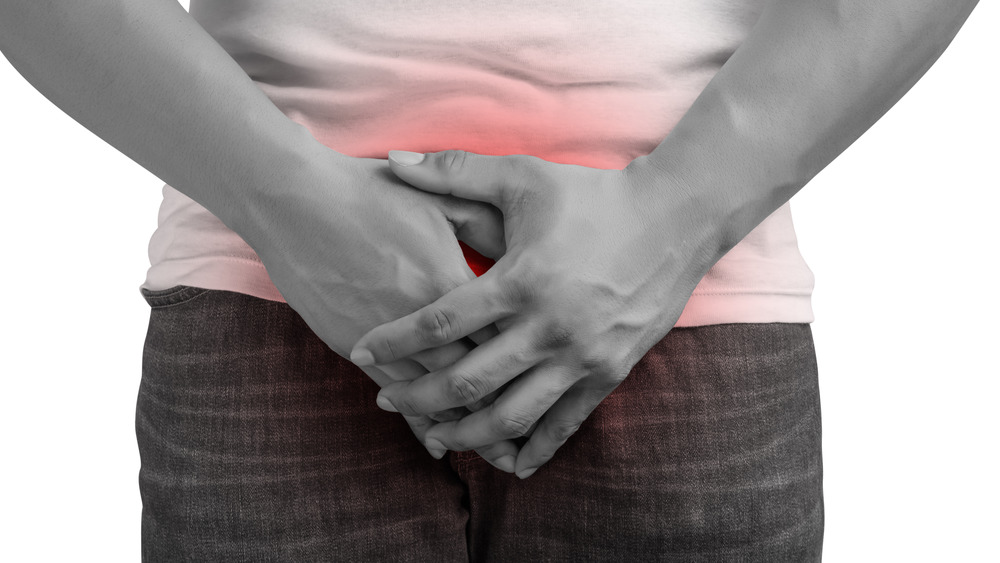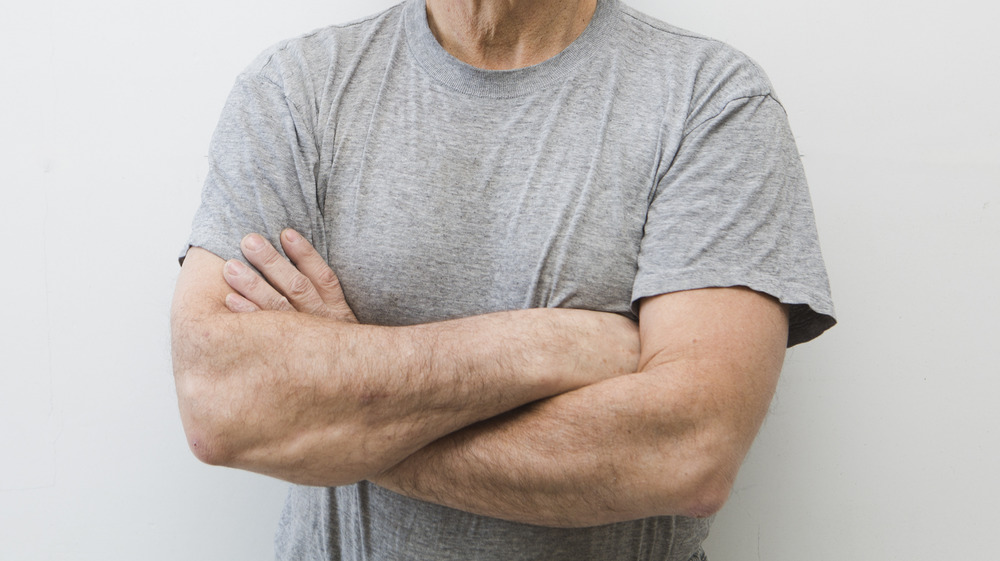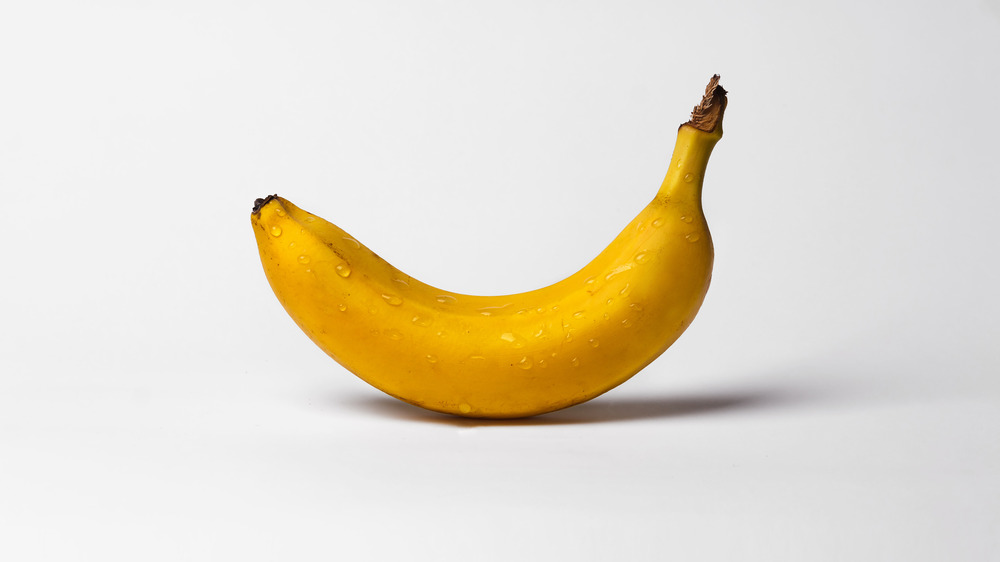Things That Happen To The Male Body That Might Surprise You
For a long time, medical and health research mostly used male subjects and thus excluded women from clinical trials (via The Guardian). That's changing, although there's still room for improvement. It's safe to say that due to the long-time bias, science has learned a lot about the male body. And some of what's been gleaned is pretty wild.
Maybe you're a guy who thinks he knows his own body pretty well, or perhaps you're a woman who considers male biology to be pretty dull compared to things like childbirth and menopause. Well, you may be in for a surprise. For example, did you know that under some conditions men can actually lactate? Or that men don't discriminate between colors as well as women?
Prepare yourself for a journey into the weirder side of living with a Y chromosome. Fair warning: You may never look at your man, or yourself, the same way again.
Men are more likely than women to be hospitalized for a UTI
Women are more likely than men to contract urinary tract infections (UTIs). It's an unfortunate consequence of anatomy: Women have a shorter urethra, which means infecting bacteria have a shorter distance to travel to reach the bladder where they can multiply (via Mayo Clinic). However, research suggests that when men do get an infection, they're more likely to be hospitalized for it.
Researchers with the Henry Ford Health System analyzed the records of over 10 million patients seen in hospital emergency rooms over the course of four years. They found that most people who were hospitalized after presenting UTI symptoms at the ER were older men, or people who had an existing kidney infection (via ScienceDaily).
However, the study also found that among women, the incidence of ER visits for a UTI infection rises sharply among ages 15 to 25 — the onset of sexual activity — and then drops, peaking again among elderly women. For men, the incidence stays low until middle age, then becomes more common as they move from middle age into old age (via Newswise).
Men get erections without feeling aroused
It's tempting to consider an erection as a hard-to-miss signal of sexual arousal. But a 2007 survey by the Kinsey Institute for Research in Sex, Gender, and Reproduction found the link between this physical event and the mental state of, well, horniness (not a scientific term) isn't as strong as you might think.
Focus-group style interviews with 50 men revealed that most did occasionally experience erections without feeling aroused. The men in the study revealed that they can occur in innocuous scenarios, like sitting at a desk or riding a bus, with comments like "It just has a mind of its own" and "I can get one and not be thinking about it." The study also found that men can feel sexually aroused without having an erection.
As one example, most men are used to waking up with an erection. In fact, a man's nervous system can trigger multiple erections during the course of a night's sleep, explained urologist Ryan on Cleveland Clinic. Sometimes these logjams might be related to an erotic dream, but they can also be due to a full bladder pressing against and stimulating the sacral nerve, which controls the erection reflex.
Men get Parkinson's disease more frequently than women
Parkinson's Disease (PD) is a neurodegenerative disorder that affects about 1 percent of the population over 60, and about 5 percent of people over age 85 (via ParkinsonsDisease.net). The disorder is due to a loss of nerve cells in a certain part of the brain, producing tremors, difficulty walking, balance problems, muscle stiffness, and other symptoms, according to the Parkinson's Foundation.
Compared to women, men are more than twice as likely to develop PD, as published in a 2019 academic review in the Journal of Parkinson's Disease. The incidence of the disorder increases with age for both men and women, but for men that increase in risk is steeper. However, the mortality rate from PD is higher among women, and the disease also progresses faster in women than in men.
The symptoms of PD are different in men and women, with women more likely to have tremors and a risk of falling, while men more often develop "freezing of gait," i.e. an inability to walk. The reasons for this aren't known, as PD is a complex disorder. But it's thought that sex hormones play a role, with estrogen offering some protection to women, at least until menopause.
Men's arms seem to be especially good for punching
In many species of animals, the males are bigger, and have bigger biological weapons (bigger teeth or claws) than the females. Often the reason is that males have to compete with each other for mates, according to a 2020 research article in the Journal of Experimental Biology. This phenomenon is especially prominent among primates: Male chimps fight each other to the point of serious injury or death. Among gorillas, males from different groups fight about 50 percent of the time that they meet.
It turns out that human male bodies, too, have been shaped for battle by evolution. As revealed in the research article, researchers measured the punching power of men and women by having volunteers turn the crank of a flywheel. This experiment used the same muscle groups and motion as throwing a punch, with the advantage that the untrained study subjects could use full force without risking injury.
Men were able to generate more force than women, but the difference was notably higher for turning the crank forward — the equivalent to throwing a punch — than for a backward or overhead pulling motion. And the difference between forward-punching force and backward-motion force was bigger for men than women. All of which suggests that men's arms are, well, specialized for punch-throwing.
Men get more or less fertile depending on the underwear they wear
Boxers or briefs? The answer could make a difference for men hoping to start a family, according to a study of over 600 male partners of couples seeking treatment for infertility. Sperm production requires that the male reproductive glands be kept slightly cooler than body temperature, which is why a man's testes are dangling outside the body in the scrotal sac, instead of tucked away with the rest of his internal organs. Tight underwear, though, may defeat this purpose by pressing those sperm factories (which can produce 1,5000 sperm per second, according to National Geographic) close to the body and raising the temperature.
In the study, researchers explored this possibility by polling the men about the type of underwear they typically wore, analyzing their semen samples, and comparing the results. It turned out that the men who usually wore boxers (about half of the group, if you're keeping track) had a higher concentration of sperm and a higher sperm count than men who favored tighter shorts.
Men develop bigger noses relative to their body size than women
When puberty hits, lots of things change. And one of them, according to an analysis of growth patterns in males and females published in the American Journal of Physical Anthropology, is the male nose. Examining data from a study that measured facial growth in a group of people from childhood through age 18, they found that differences in face size, relative to body size, between males and females already exists in early childhood. But beginning at adolescence, boys start developing a bigger-sized nose relative to their faces than girls do. They also develop relatively bigger nasal cavities.
The reason for this, the researchers said, is the other changes that happen during puberty. Males start to develop a greater proportion of lean body mass (muscle) than females. And since it takes more oxygen to sustain muscle mass, men need to take in more oxygen for their body size than women. Developing a big honker and more spacious nasal cavities appears to be an adaptation to meet that need.
Men get enlarged breasts
Gynecomastia is the medical term for male breast enlargement. And yes, men do have breast tissue, though not as much of it as women do. A hormonal imbalance — specifically, a lack of testosterone in relation to the amount of estrogen — can cause the breast tissue to enlarge, producing swollen or enlarged breasts. And yes, men do produce both testosterone and estrogen (via Gynecomastia.org).
Besides so-called "moobs" (ugh), gynecomastia symptoms can include itching or tenderness of the chest, pain, bloody discharge from the nipples, or fever. It can affect one or both breasts. Generally, gynecomastia is not a serious concern, according to the Mayo Clinic, but it can be distressing. It can occur among adolescent boys, as their hormone levels fluctuate, but will likely disappear with time. It's also common in older men, affecting at least one out of four men aged 50 to 69.
According to a report in the New England Journal of Medicine, men whose gynecomastia doesn't include uncomfortable symptoms, and who aren't bothered by it, don't need any particular treatment aside from a check of their hormone levels. Other treatment options can include medication and surgery.
Yes, men get breast cancer
Breast cancer is exceedingly rare in men; male breast cancer makes up about 0.6 to 1 percent of breast cancer cases, according to an examination of data from the National Cancer Database. And it represents only about 0.3 percent of all cancer in men. But it does occur. And it's on the rise, with rates increasing by 40 percent between 1975 and 2015, compared to a 24.7 percent increase in the rate of breast cancer among women.
As the report in JAMA Oncology highlighted, men with breast cancer may have a worse survival rate compared to women. They also tend to be diagnosed at a later stage of the disease. This could be due to a lack of awareness and screening among men. Even when diagnosed, men are less likely than women to receive "conventional treatment."
The reasons for these differences aren't clear. It could be that men are less likely to comply with treatment recommendations, and that lifestyle issues like alcohol use affect their prognosis. But there may be biological factors involved, the researchers say. The disease may behave differently in men than it does in women.
Men signal how strong they are via dance moves
Watching a dude's sweet moves on the dance floor might reveal his rhythm and agility. But good dancing also seems to signal a man's strength — a signal that men and women alike recognize. As part of a 2013 study published in the American Journal of Human Biology, researchers documented this by recording 30 men dancing — separately — to a recorded drum beat. Using a motion capture system, images of the dancers were changed into a featureless animated avatar, so that observers couldn't glean any info about the dancer except his movements. The researchers also measured the dancers' physical fitness with a number of tests.
Next, the dance avatars were observed by 27 women and 21 men, who rated the dance quality of each. Comparing the ratings to the lab data revealed that men who had the best upper body strength (which had been measured in a test of grip strength) tended to get the highest ratings by both men and women. Keep in mind that the raters couldn't actually see how muscular the dancers were, or anything else except the moves they made. Interesting to note, neither cardiovascular fitness or leg strength had an effect on dance rating. Only upper body strength seemed to move the needle. The researchers concluded, writing, "Male dancing may form a condition‐dependent ornament of certain aspects of mate quality."
Success raises a man's testosterone level, while failure lowers it
Research has shown that men who win a competition experience a boost in testosterone. This is true whether it's a physical contest like a wrestling match, or a non-athletic game like chess. But is it the victory that triggers the hormonal payoff, or is it a consequence of the effort it took to come out on top?
A team of scientists examined this by testing a group of men before and after they competed in a virtual race using rowing machines (via ScienceDaily). What the rowers didn't know was that the race was a sham; the winner was selected at random and had nothing to do with athletic performance. Although their physical effort was unrelated to success or failure, the "winners" had an average testosterone increase of 4.92 percent, while the "losers" had a drop in testosterone levels of 7.24 percent. Surveys showed that the men who won had a boost in self-esteem as well, and were more willing to approach women in a hypothetical social situation.
According to the researchers men may be wired this way because, as in other social animals, successful competition can raise one's social status, which increases the chance to find a mate.
Men sweat more than women
Fact: Men make better sweaters. Studies show that women's sweat glands release less sweat than men at a given temperature. The cause seems to be the hormone testosterone, which increases sweat output. Yet in both men and women, athletic training leads to increased sweating, as the body gets better at keeping itself cool during exercise. Does that mean that women can achieve a man's level of drippiness?
Apparently not; even among athletes, men come out ahead in this dubious achievement. Researchers tested a group of men and women while they were cycling. Some of the exercisers had been competing in endurance sports for over six years, while others hadn't engaged in any regular exercise for the previous three years.
Among both men and women, sweat output was higher for the trained athletes compared to the non-athletes. The athletic men maintained a higher sweat output than the athletic women. What's more, the difference in sweating between athletic and non-athletic men was markedly greater than the difference between the two groups of women. This suggests that athletic training has a bigger impact on male sweating.
A percentage of men get Peyronie's disease
It's called Peyronie's disease, and it affects 4 percent of men over age 40, according to the American Urological Association. And 75 percent of men who have the condition are stressed and depressed about it, says the AUA.
Peyronie's can happen when scar tissue forms in the tunica albuginea, which is the "fibrous sheath" beneath the skin of the penis. It's often the result of a minor injury during vigorous sex, or from a sports injury or other accident. Scar tissue makes the penis less flexible, causing a bend during an erection: upward, if the scar's on top, downward or sideways if the scar tissue is on the underside or side. Multiple areas of scar tissue can cause multiple bends. It's also possible that some men are more prone to this type of scarring.
The disease can cause painful erections, particularly in its early stage, as well as difficulties with sex. But for some men it's a mild condition with no symptoms other than, well, packing a scimitar instead of a longsword. Treatment options include drugs, most of which haven't been shown to be very effective, and surgery for extreme cases.
Men gain weight if they marry
To love, honor, and enlarge? In a 2017 analysis of health and lifestyle data from nearly 9,000 men published in Social Science & Medicine, researchers determined not only that married men weigh more than single men, but also that men on average weigh less before marriage, more after they get married, and less after they get a divorce.
According to the researchers, there are two explanations for this phenomenon, and they're not mutually exclusive. The first, called the "marriage market" theory, is that men who are looking for a partner have more incentive to stay fit. Once they marry, they "let themselves go," so to speak, and gain weight. The other explanation is called the "social obligation" theory. It states that once they marry, men eat more regular meals and attend more social events that include eating high-calorie food, hence the expanding waistline. In both scenarios, the situation reverts after a divorce, although the stress of the divorce itself may also lead to weight loss.
Whatever the reason, the good news is the effect seems small — three pounds on average — and so it's unlikely to have much impact on anyone's health (via Forbes).
Men seem more masculine if they use deodorant
The scent of a man is more "manly" if it includes an artificial fragrance, at least according to a 2015 study that investigated how body odor influences perception. Researchers collected "odor samples" from 40 volunteers by having them wear a cotton pad under their arms for 24 hours. Each person was sampled twice, once while wearing their usual deodorant, and once without any deodorant. The donors were also photographed.
A different group of volunteers then rated the masculinity and femininity of the odor samples and the photographs. For men whose facial features were rated by women as low in masculinity, a body odor sample with deodorant increased those ratings, bringing their score on par with men whose photos had high-masculinity scores.
"This means that men are able to use deodorant to artificially raise their game so to speak, leveling the playing field by making themselves comparable, at least as far as odor is concerned, to more masculine men," said study director Caroline Allen, psychology researcher at the University of Stirling, in a press release about her research.














